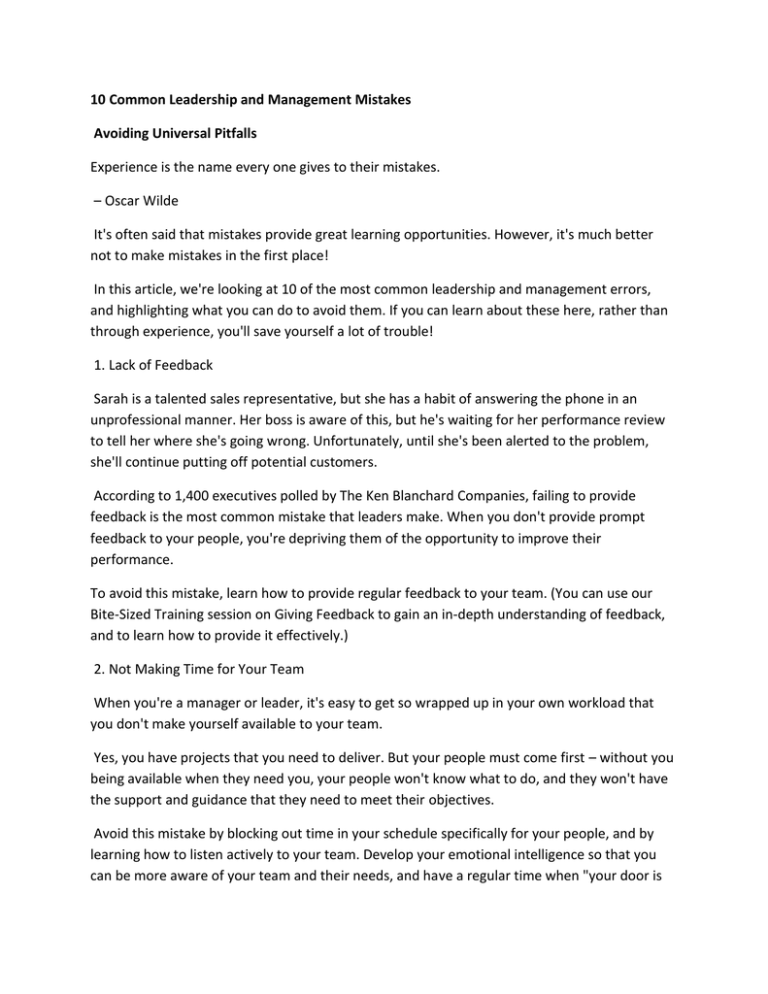10 Common Leadership and Management Mistakes
advertisement

10 Common Leadership and Management Mistakes Avoiding Universal Pitfalls Experience is the name every one gives to their mistakes. – Oscar Wilde It's often said that mistakes provide great learning opportunities. However, it's much better not to make mistakes in the first place! In this article, we're looking at 10 of the most common leadership and management errors, and highlighting what you can do to avoid them. If you can learn about these here, rather than through experience, you'll save yourself a lot of trouble! 1. Lack of Feedback Sarah is a talented sales representative, but she has a habit of answering the phone in an unprofessional manner. Her boss is aware of this, but he's waiting for her performance review to tell her where she's going wrong. Unfortunately, until she's been alerted to the problem, she'll continue putting off potential customers. According to 1,400 executives polled by The Ken Blanchard Companies, failing to provide feedback is the most common mistake that leaders make. When you don't provide prompt feedback to your people, you're depriving them of the opportunity to improve their performance. To avoid this mistake, learn how to provide regular feedback to your team. (You can use our Bite-Sized Training session on Giving Feedback to gain an in-depth understanding of feedback, and to learn how to provide it effectively.) 2. Not Making Time for Your Team When you're a manager or leader, it's easy to get so wrapped up in your own workload that you don't make yourself available to your team. Yes, you have projects that you need to deliver. But your people must come first – without you being available when they need you, your people won't know what to do, and they won't have the support and guidance that they need to meet their objectives. Avoid this mistake by blocking out time in your schedule specifically for your people, and by learning how to listen actively to your team. Develop your emotional intelligence so that you can be more aware of your team and their needs, and have a regular time when "your door is always open", so that your people know when they can get your help. You can also use Management By Walking Around, which is an effective way to stay in touch with your team. Once you're in a leadership or management role, your team should always come first - this is, at heart, what good leadership is all about! 3. Being Too "Hands-Off" One of your team has just completed an important project. The problem is that he misunderstood the project's specification, and you didn't stay in touch with him as he was working on it. Now, he's completed the project in the wrong way, and you're faced with explaining this to an angry client. Many leaders want to avoid micromanagement. But going to the opposite extreme (with a hand-offs management style) isn't a good idea either – you need to get the balance right. Our article, Laissez Faire versus Micromanagement will help you find the right balance for your own situation. 4. Being Too Friendly Most of us want to be seen as friendly and approachable to people in our team. After all, people are happier working for a manager that they get on with. However, you'll sometimes have to make tough decisions regarding people in your team, and some people will be tempted to take advantage of your relationship if you're too friendly with them. This doesn't mean that you can't socialize with your people. But, you do need to get the balance right between being a friend and being the boss. Learn how to do avoid this mistake with our article, Now You're the Boss. Also, make sure that you set clear boundaries, so that team members aren't tempted to take advantage of you. 5. Failing to Define Goals When your people don't have clear goals, they muddle through their day. They can't be productive if they have no idea what they're working for, or what their work means. They also can't prioritize their workload effectively, meaning that projects and tasks get completed in the wrong order. Avoid this mistake by learning how to set SMART goals for your team. Use a Team Charter to specify where your team is going, and detail the resources it can draw upon. Also, use principles from Management by Objectives to align your team's goals to the mission of the organization. 6. Misunderstanding Motivation Do you know what truly motivates your team? Here's a hint: chances are, it's not just money! Many leaders make the mistake of assuming that their team is only working for monetary reward. However, it's unlikely that this will be the only thing that motivates them. For example, people seeking a greater work/life balance might be motivated by telecommuting days or flexible working. Others will be motivated by factors such as achievement, extra responsibility, praise, or a sense of camaraderie. To find out what truly drives your people, read our articles on McClelland's Human Motivation Theory and Theory X and Theory Y. Then take our test "How Good Are Your Motivation Skills?" to learn how to be a great motivator of people. 7. Hurrying Recruitment When your team has a large workload, it's important to have a full team. But filling a vacant role too quickly can be a disastrous mistake. Hurrying recruitment can lead to recruiting the wrong people for your team: people who are uncooperative, ineffective or unproductive. They might also require additional training, and slow down others on your team. With the wrong person, you'll have wasted valuable time and resources if things don't work out and they leave. What's worse, other team members will be stressed and frustrated by having to "carry" the under-performer. You can avoid this mistake by learning how to recruit effectively, and by being particularly picky about the people you bring into your team. 8. Not "Walking the Walk" If you make personal telephone calls during work time, or speak negatively about your CEO, can you expect people on your team not to do this too? Probably not! As a leader, you need to be a role model for your team. This means that if they need to stay late, you should also stay late to help them. Or, if your organization has a rule that no one eats at their desk, then set the example and head to the break room every day for lunch. The same goes for your attitude – if you're negative some of the time, you can't expect your people not to be negative. So remember, your team is watching you all the time. If you want to shape their behavior, start with your own. They'll follow suit. 9. Not Delegating Some managers don't delegate, because they feel that no-one apart from themselves can do key jobs properly. This can cause huge problems as work bottlenecks around them, and as they become stressed and burned out. Delegation does take a lot of effort up-front, and it can be hard to trust your team to do the work correctly. But unless you delegate tasks, you're never going to have time to focus on the "broader-view" that most leaders and managers are responsible for. What's more, you'll fail to develop your people so that they can take the pressure off you. To find out if this is a problem for you, take our interactive quiz, How Well Do You Delegate? If you need to improve your skills, you can then learn key strategies with our articles, Successful Delegation, and The Delegation Dilemma. 10. Misunderstanding Your Role Once you become a leader or manager, your responsibilities are very different from those you had before. However, it's easy to forget that your job has changed, and that you now have to use a different set of skills to be effective. This leads to you not doing what you've been hired to do – leading and managing. Our articles Now You're The Boss and From Technical Expert to Manager provide more information on the additional skills that you need to develop to be an effective manager. Make sure that you learn these skills – you'll fail if you try to rely on technical skills alone, however good they are!







